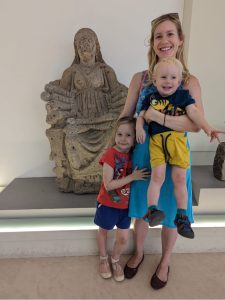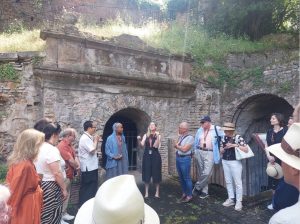This is a longer version of Prof Sarah Beckmann’s entry in the Summer 2023 Classics Department Newsletter.
Greetings from Rome! It is late July, and the heat wave in southern Europe has finally lifted. Now, with the return of a gentle breeze and balmy temperatures in the mid-80s, just as Rome begins to feel habitable once again, I’m reaching the end of my year as the 2022-23 Andrew Heiskell fellow in ancient studies at the American Academy in Rome. I’m looking forward to returning to UCLA and southern California soon (to life with street tacos, a morning marine layer, and the easy availability of industrial-strength air-conditioning), but still, the impending conclusion of a momentous and rewarding year in the eternal city is bittersweet.

Sarah with Sally and Julian and a votive statue of a mother
with 12 swaddled babies at the Museo Campana in Capua
I applied for the Rome Prize to help me reconceptualize my book project, an archaeology forward history of the late Roman villa in the western provinces. The fellowship year gave me much needed time to restructure the monograph. It is now organized around a discussion not only of the elite owners of these structures (part I of the book), but also and perhaps more importantly, a consideration of the subaltern populations responsible for the care and maintenance of these sites (part II). At the AAR I worked primarily on part II. I’ve explored the ways that a bottom-up approach to villas builds space for synthetic discussion of the full social spectrum of actors at Roman villas, from elite senators to enslaved laborers, and their varied experiences. I am grateful for the chance to present early work in this vein at the AAR and other institutions in Rome; and for the chance to visit villas throughout the Italian Peninsula, many of which are proving themselves as worthy comparanda for my own villas, which are temporally and geographically distant from Rome.
The freedom to travel in and around Italy over the past year, moreover, has (re)kindled research interests in other subjects, specifically in artistic representations of women and children, and the sculptural traditions of several pre-Roman Italic groups in central and southern Italy. I spent a good amount of time in Pompeii and the Bay of Naples as a matter of course (I hope everyone reading has a chance to do the same one day!), but some highlights off the beaten path include the Museo Campana in ancient Capua (see their collection of matres matutae, or ca. 4th – 1st c. BCE ex-voto statues of enthroned mothers holding anywhere from one to twelve swaddled babies) and the Museo archeologico nazionale d’Abruzzo (with the 6th c. BCE Guerriero di Capestrano statue, a free-standing funerary statue of a warrior, a monumental example of a local Italic sculptural tradition seemingly independent from Greek influence).
While I certainly embraced the break from teaching that this fellowship granted me, I’ve also come to realize the depth of my avowed interest in pedagogy, and more specifically, in different ways that we as classicists might better connect modern audiences with the ancient world.Without a classroom of my own, I was free to explore these questions in different venues, e.g. on “walk and talks”, or thematic tours of various aspects of the Roman city. I led several for the AAR community, and one in particular merits a more detailed description – a collaborative tour on the funerary traditions of ancient Rome led by myself (an archaeologist) and another fellow, Jasmine Hearn, who is a dancer, choreographer, doula, artist, and archivist. Our tour of the Tomb of the Scipios and the Columbarium of Pomponius Hylas aimed to connect participants with Roman antiquity using both their mind and their body. I led tours of aforementioned sites, using history and archaeology to explain Roman attitudes towards death; Jasmine complemented this work with a series of embodiment scores to help participants listen and experience antiquity in new ways, with reflections on how we as humans retain memories (in our minds but also our bodies), on different ways we grieve, and the myriad ways we move through this world bridging the past and future with our lives, thoughts, and bodies. From conceptualization to delivery, this was a true collaboration, and Jasmine and I are looking forward to working together again soon, e.g., I’m currently trying to find a way to bring them and their work to my UCLA classroom to better connect the next iteration of Cl 51b (Art and Archaeology of Ancient Rome) to ancient histories and embodied research.

Sarah and Jasmine Hearn leading a tour of the Tomb of the Scipios, June 6, 2023
Indeed, one of the greatest joys of this past year has been working alongside a larger community of scholars and artists. Living amongst such persons and participating in this community, which was especially amichevole (friendly) this year, was the most rewarding part of my year as a fellow. I have many happy memories of quotidian interactions with my fellow fellows: morning coffee chit-chats; conversations over meals about work and especially the food itself (special thanks to Rome Sustainable Food Project, who cooked for us); stimulating discussions after the works-in-progress talks of other fellows (which often spilled over into lunchtime); and celebratory gatherings of every kind with fellows and their families on the rooftop terrace of the Academy, or in the nearby parco giochi (playground). Put another way, this fellowship did not simply deliver the Rome Prize’s advertised “time and space to think and work”; it allowed me to be part of a supportive, generous, and inspiring community of artists, intellectuals, and long-time staff. I will be forever grateful for the friendships that arose in the course of this past year.
I could go on and on, boring you with additional memories and photos, but let me close with a few updates about my family, who also really loved living in Rome. My partner Sam divided histime by teaching asynchronously for UCLA (recording videos for his course in Medical Latin at various locations throughout Rome) and pursuing his own research interests in early Latin poetry and grammar in the cool cryptoporticus of the AAR library. My children Sally (now almost 5) and Julian (almost 2) attended an Italian preschool where they cultivated new interests in, respectively, gymnastics and comedic performance (a budding animatrice, maybe!), and calcio, vespas, and horticulture. I am simultaneously proud and ashamed to report that questi bimbiparlano meglio di loro madre, haha. We are now looking for Italian-speaking playmates to keep their budding bilingualism active, so please reach out if you or someone you know has a tinyItalian speaker in the home! And if you and your family are thinking about spending time abroad or similar, please know I’m happy to share additional stories of the joys, frustrations, and various bureaucratic headaches that made for a truly memorable year.
A presto! xx, Sarah
See also:
Jasmine Hearn: https://www.jasminehearn.com/
Rome Sustainable Food Project: https://www.aarome.org/about/rome-sustainable-food-project

